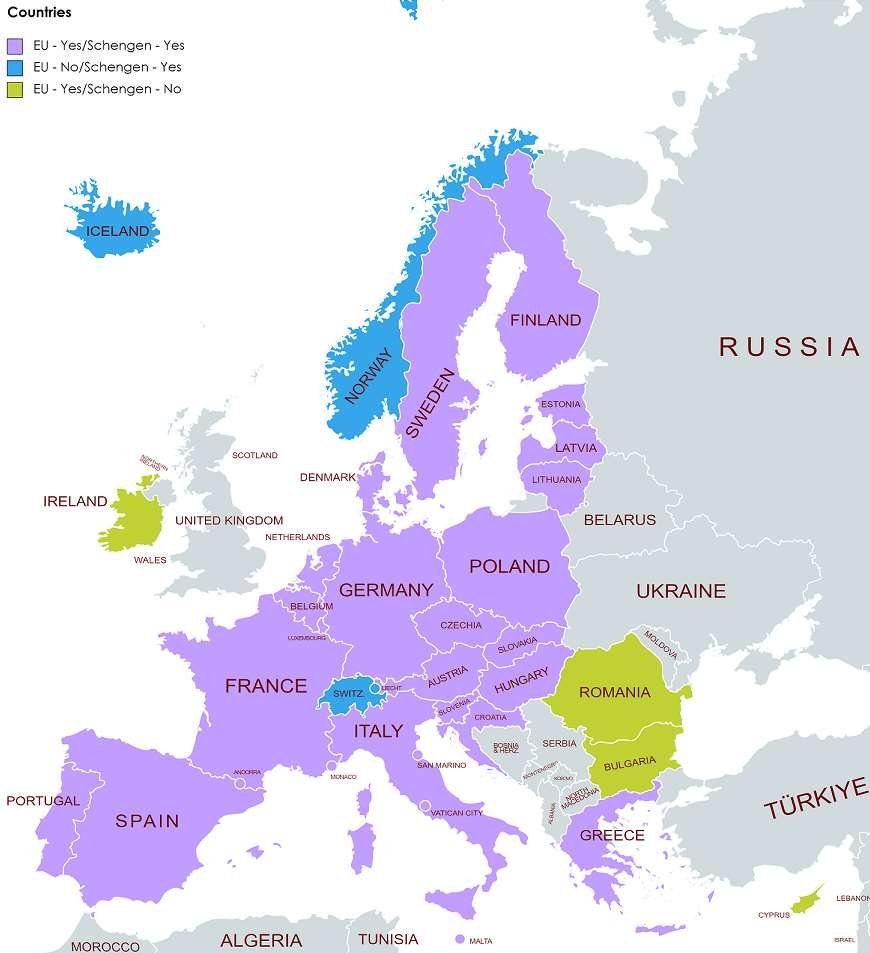Introduction
Romania and Bulgaria are scheduled to join the European Union’s (EU) passport-free Schengen Zone for air and sea travel on 31 March 2024.
What is the Schengen Area?

The Schengen Area represents a region in which 27 European nations have eliminated their internal borders, allowing individuals to move freely without visas or border checks. This initiative operates under unified regulations for monitoring external borders and combating crime, bolstering the collective judicial system and fostering police collaboration. Included in the Schengen Area are countries such as Austria, Belgium, Czech Republic, Croatia, Denmark, Estonia, Finland, France, Germany, Greece, Hungary, Iceland, Italy, Latvia, Liechtenstein, Lithuania, Luxembourg, Malta, Netherlands, Norway, Poland, Portugal, Slovakia, Slovenia, Spain, Sweden, and Switzerland.
Features of the Schengen Zone
| Unestricted Movement | NaMonals from any country can freely cross internal borders within the Schengen Area without undergoing border checks. |
| Uniform Border Standards | There are standardized regulations for crossing external borders. |
| Unified Visa Conditions | Member states follow consistent entry and short-stay visa rules, integrating the European Travel Information and Authorization System (ETIAS). |
| Enhanced Law Enforcement Collaboration | Improved cooperation among member countries’ police forces. |
| Judicial Cooperation | Schengen Agreement facilitates faster extradition of criminals and simplifies the relocation for executing criminal verdicts among member states. |
| Shared Information System | The Schengen Information System (SIS) allows quick exchange of information about individuals and goods among member countries. |
| Policing Measures | While substantial freedom prevails in the Schengen Area, police retain the authority to conduct checks at internal and border areas under specific circumstances. They may request information regarding individuals’ stays in the Schengen Zone and related details |
| Temporary Border Control | In cases of severe internal security threats, a member country can temporarily reintroduce border checks at internal borders, but not exceeding a 30-day period. |
Criteria to become Schengen Member Country
There are some pre-conditions or criteria that countries willing to join must have the capacity, or need further preparation, to deal with, such as:
- To be able, on behalf of other member countries, to control the external borders of the Area as well as to issue Uniform Schengen Visas
- To possess the competence that, acer the abolishment of border controls between member states, to capably collaborate with other member countries’ law enforcement agencies for a greater level of security
- To be equipped in applying ‘Schengen Acquis’ or rules for controlling land, sea and air borders, issuing short-stay visas, police collaboration as well as protection of personal data
- To be ready to join and put in use the Schengen Information System (SIS)
- Before joining the visa-free Area, the aspirant country is prone to a Schengen Evaluation. Acerwards, a member country undergoes a periodical evaluation to ensure the appropriate application of Schengen Acquis.
Challenges in accession of Romania and Bulgaria to the Schengen Area
Romania and Bulgaria joined the European Union (EU) in 2007 and met Schengen entry criteria by 2010, but their membership in the border-free area was held up due to concerns about graft and, later, the perception that they would do little to stop migrants from the Turkish and Western Balkan routes. The Netherlands had also opposed the move for years but lifted its veto to the first stage of accession when Austria relented. At a meeting of EU Interior Ministers, Austria reiterated the need for Schengen toimprove rather than expand.
While Bulgarian Prime Minister Nikolay Denkov highlighted the strengthened borders that Romania and Bulgaria’s Schengen accession would bring, Vienna’s stance remained unaltered. Austrian Chancellor Karl Nehammer maintained Austria’s veto, emphasizing broader issues within the Schengen system, where 11 EU states, including the Czech Republic, Poland, Germany, Italy and France imposed internal border controls due to systemic challenges of security such as illegal migration, increased threat of violence within the EU following the war in the Middle East and increase terrorist threats.
Meanwhile, Vienna’s opposition was criticized for potential EU weakening and domestic political motivations amid rising far-right sentiment while the conservative-led coalition government faced internal pressure to adopt a stricter stance on immigration before the June 2024 elections.

Croatia, which joined the EU six years acer Romania and Bulgaria, was allowed to become a full Schengen member in January 2023, a decision that angered the governments in Sofia and Bucharest. To increase the pressure, Romania in 2023 threatened to sue Vienna for several billion euros and told Austrian energy company Österreichische Mineralölverwaltung AkMengesellschac (OMV) that a joint gas drilling project in the Black Sea would suffer delays unless Schengen moved forward. Bulgaria introduced a punitive transit tax on Russian gas crossing its territory, some of which end up in Austria. However, Sofia was forced to scrap the levy acer Hungary threatened to veto its Schengen accession.
In mid-December 2023, Austria softened its stance, proposing passport-free air travel for both countries in exchange for reinforced border security measures. Following the proposal of ‘Air Schengen’ by Austria, the European Commission expressed support, outlining four conditions for implementation:
- A threefold increase in the European Border and Coast Guard Agency (Frontex) staff in Bulgaria, with financial support for frontier protection infrastructure.
- Enhanced border surveillance between Romania-Bulgaria and Hungary-Romania.
- Austrian advisors collaboraMng with airport teams in Romania and Bulgaria on document-related issues.
- Both Balkan countries accepMng asylum seekers, parMcularly from Afghanistan and Syria.
Current status of the agreement implementation

- The European Commission initially confirmed Bulgaria and Romania’s readiness to join the Schengen Area without internal border controls back in 2011. Since then, both countries have consistently showcased their fulfilment of Schengen membership criteria through three fact-finding missions at their external borders in 2022 and 2023. Additionally, the Commission initiated pilot projects with both nations in March 2023 to bolster external border management, enhance collaboration with neighbouring states, and expedite asylum and return procedures.
- Following prolonged negoMaMons, the authoriMes from Romania, Austria, and Bulgaria reached a poliMcal agreement, mediated by the Spanish rotaMng presidency of the Council of the EU, on parMal entry into the Schengen Zone on 23 December. The upcoming enlargement of the Schengen Zone with Bulgaria and Romania marks the ninth expansion since the establishment of the borderless zone in 1985. The elimination of checks at sea and border entry points is set for 31 March, aligning with the International Air Transport Association’s winter/summer schedule, ensuring a coordinated transition.
- Spanish Minister for the Interior, Fernando Grande-Marlaska Gómez, hailed the EU’s decision to allow the gradual Schengen Accession of these two countries as a step toward creating a broader and more robust area of free movement.
Ongoing negotiations and future expectations
- The Schengen accession for Romania and Bulgaria by land is slated to be determined post 31 March 2024. While advancements at airports and seaports are laudable, the decision regarding land borders carries significant weight, particularly considering the historical challenges of prolonged road and rail border wait times in the region.
- According to Bulgarian finance minister Assen Vassilev, the full economic impact of accession won’t be realized untill land borders are opened. Both Bulgaria and Romania have committed to fortifying external border controls, placing emphasis on Bulgaria’s southern frontier. Bulgaria anticipates substantial financial support and operational aid from the European Commission along its borders with Turkey and Serbia.
- Several successful pilot projects developed by Bulgaria and Romania at their external borders are slated for integration into a more structured framework. The EU pledges continued substantial financial assistance and Frontex support to ensure effective supervision of their non-EU borders.
- Austria contends that Romania’s inclusion of land borders in the Schengen Area necessitates specific compensatory measures focusing on reinforced border control and compliance with the Dublin Agreement. The Dublin Agreement, an EU regulation, delineates criteria for determining asylum application processing responsibilities among member states. For Romania’s alignment with the Dublin Agreement, adherence to the Dublin III Regulation is crucial, encompassing aspects like asylum request.

- Between 10 and 16 November 2023, 700 individuals were subject to Schengen Information System (SIS) alerts, with 653 found in Romania and 127 identified by foreign partners; actions included executing 17 European warrants, detecting 87 individuals banned from Schengen, and locating 221 wanted for judicial procedures. For Austria, the figures may reinforce the opposition to Romania’s entry into the Schengen Area by land.
- A joint declaration involving Austria, Romania, and Bulgaria on refugee readmission has garnered attention, emphasizing the swift repatriation of asylum seekers from these countries, particularly those from conflict-affected regions like Syria and Afghanistan. Despite concerns about potential refugee influxes into Bulgaria, leadership within the country have dismissed such apprehensions.
Key implications of Romania and Bulgaria joining air and maritime Schengen Area
The partial accession of Bulgaria and Romania into the Schengen Area through air and maritime routes brings forth several implications:
| Ease of Movement | Enabling over 400 million travelers to move freely within the Schengen Area without undergoing passport controls or acquiring separate visas for each visited country. |
| Trade Facilitation | Streamlining the movement of goods within the Schengen Area by eliminating internal border controls, reducing transit times, and administrative burdens. |
| Supply Chain Efficiency | Enhancing smoother supply chains for companies involved in manufacturing or distribution across Schengen countries due to reduced customs checks and administrative procedures. |
| Market Access | Providing businesses easy access to a market of over 400 million consumers within the Schengen Zone, eliminating barriers related to visa requirements or border checks. |
| Cost Savings | Reducing bureaucracy and administrative overheads associated with customs clearance and border controls, resulting in cost savings for businesses. |
| Business Collaboration | Fostering collaboration, networking, and partnerships among companies situated in different Schengen countries, promoting knowledge exchange and joint ventures. |
| Attractiveness for Investment | Creating a streamlined cross-border environment, making the region more appealing for foreign investment due to stability and conducive economic activities. |
| Improved Competitiveness | Providing businesses, a competitive advantage through efficient movement of goods, services, and human resources in both regional and global markets |
| Tourism and Services Sector | Encouraging tourism and benefiting service-oriented businesses like hospitality, transportation, and tourism-related industries, contributing to sectoral economic growth. |
Business Impacts
- The partial accession implies that citizens from Romania and Bulgaria will be able to travel without undergoing passport controls, departing from the same Schengen terminals as other EU and Schengen member states. This freedom will extend to passengers on ferries and other boats. It will facilitate movement for short-term travelers, eliminating the need for immigration and customs clearance at internal borders, benefiting long-term EU residents in Bulgaria and Romania, including digital nomads, students, and immigrant families.
- All Schengen visa holders will be able to add Romania and Bulgaria to their Europe travel itinerary.
- Schengen travel insurance would remain mandatory if travel to the EU/Schengen Area necessitates a Schengen visa. The Schengen expansion precedes the 2025 launch of the ETIAS scheme, where the ETIAS visa waiver will be obligatory for visa-free entry into the Schengen Zone.
- For businesses involved in trade/logistics, there would be a streamlined transportation of goods via air and sea routes between Romania, Bulgaria and other countries in the Schengen Area. Reduced administrative procedures and transit times may be anticipated.
- However, land border crossing remains restricted for now. Until achieving full Member State status, Bulgaria and Romania will issue national entry visas instead of Schengen visas. Romanian Prime Minister Marcel Ciolacu expressed optimism about future negotiations on land borders, anticipating a conclusion in 2024, although an exact date remains uncertain.
- Private companies operating within the Schengen Area may experience changes in data sharing regulations or requirements, especially under the unified Schengen Information System (SIS). With improved coordination between security agencies, there might be increased sharing of information related to security threats, criminal activities, or individuals of interest. This could raise concerns about data privacy and compliance with regulations like GDPR (General Data Protection Regulation).
- The provision for temporary reintroduction of border checks during severe security threats within the Schengen Area might require businesses to be prepared for sudden security measures, impacting travel and operations.
With 27 countries encompassing over four million square kilometers and a population of nearly 420 million, the Schengen Area will expand with Romania and Bulgaria, growing to 4.5 million square kilometers and a popula9on of 450 million.
Outlook
The inclusion of Romania and Bulgaria in the Schengen Area appears imminent. EU Treaties dictate that all EU member states should eventually become full members of Schengen when deemed ready, a commitment accompanied by rights and obligations. The EU Commission has acknowledged both countries for their commendable implementation track records. This anticipated relaxation of land controls carries significant economic implications, particularly in terms of facilitating smoother commercial traffic and reducing transit times for trucks crossing the Danube River from Greece and Turkey.
The addiMon of Bulgaria and Romania to the Schengen Area is perceived as a precursor to broader changes in EU immigraMon policies. The bloc conMnues its gradual approach toward fully open internal borders among member states. This step precedes the 2025 rollout of the ETIAS program, mandating pre-travel authorization for visa-free visitors to the Schengen Zone. The EU’s efforts to harmonize immigration policies, through initiatives like ETIAS and ongoing Schengen expansion, aim to streamline travel while bolstering security. The phased approach of initially lifting air and sea checks before addressing land borders exemplifies the delicate balance between promoting free movement and exercising immigration control. Further policy adjustments are anticipated as the EU advances its vision of an unrestricted travel zone.
Recommendations
- Prepare for increased mobility and interaction within the Schengen Area if there are business operations within Romania or Bulgaria. This could involve revising logistics and transportation strategies to take advantage of the smoother movement of goods and services.
- Optimise supply chains to leverage reduced transit times and administrative burdens within the Schengen Zone. This may involve re-evaluating distribution networks and inventory management for enhanced efficiency.
- Ensure compliance with Schengen Area regulations and adapt operations to align with unified standards concerning border control, visa rules, and data protection. Information regarding the same can be found via the following websites:
- European Commission – Migration and Home Affairs (https://commission.europa.eu/about-european-commission/departments-and-executive-agencies/migration-and-home-affairs_en)
- European Border and Coast Guard Agency (Frontex) (https://www.frontex.europa.eu/)
- European Union (https://european-union.europa.eu/index_en)
- Schengen Visa Info (https://www.schengenvisainfo.com/)
- Conduct risk assessment related to changing border controls, migration patterns, and security measures in the face of the impending accession.

Author’s Profile
Aishwarya Nagar
GeopoliMcal Analyst
Aishwarya Nagar is an Analyst with MitKat’s Predictive Risk Intelligence (PRI) team. She holds a master’s degree in International Studies from Symbiosis School of International Studies and a bachelor’s degree in Economics from Symbiosis School of Economics. As part of the PRI-Global team, she monitors geopolitical risks in the Americas and EMEA regions and contributes to various special reports and advisories.
Contact
| Mumbai | Delhi | Bengaluru | Singapore |
| 511, Ascot Centre, Near International Airport, Andheri (E), Mumbai – 400 099 +91 22 2839 1243 | Suite #008, 4th Floor,Times Square, Sus hant Lok – 1, Gurgaon – 122 002 +91 124 455 9200 | C/O WeWork, 36, Infantry Rd, Tasker Town, Shivajinagar, Bengaluru – 560001 +91 95265 63359 | 101 Cecil Street, 23-12, Tong Eng building, Singapore – 069 533 +65 9452 1622 |






